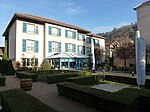Saint Peter's church, Vienne (Isère)
5th-century churches5th-century establishments in the Roman EmpireBasilica churches in FranceCarolingian architectureChurches in Isère ... and 1 more
Vienne, Isère

Saint Peter's church (Saint-Pierre-le-Bas) in Vienne is one of the oldest surviving churches in France, situated in the Rhône-Alpes region. The church was added to the 1862 version of the list of France's Monuments historiques, created in 1819.
Excerpt from the Wikipedia article Saint Peter's church, Vienne (Isère) (License: CC BY-SA 3.0, Authors, Images).Saint Peter's church, Vienne (Isère)
Place Saint-Pierre, Vienne
Geographical coordinates (GPS) Address Phone number Website External links Nearby Places Show on map
Geographical coordinates (GPS)
| Latitude | Longitude |
|---|---|
| N 45.523 ° | E 4.8707 ° |
Address
Musée archéologique Saint-Pierre de Vienne (Ancienne Eglise Saint-Pierre-le-Bas)
Place Saint-Pierre
38200 Vienne
Auvergne-Rhône-Alpes, France
Open on Google Maps






